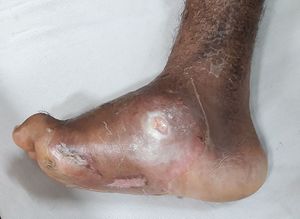Charcot Foot: Difference between revisions
No edit summary |
No edit summary |
||
| Line 7: | Line 7: | ||
== What is Charcot Foot? == | == What is Charcot Foot? == | ||
[[File:Diabetic_Charcot_Foot_Deformity.jpg|thumb]] | [[File:Diabetic_Charcot_Foot_Deformity.jpg|thumb]] | ||
Charcot foot is a rare but serious complication | Charcot foot is a rare but serious complication. It can affect persons with '''peripheral neuropathy''', especially those with [[diabetes]] mellitus. This is a condition in which the nerves in the lower legs and feet have been damaged. The damage causes a loss of sensation in the feet. It affects the bones, joints, and soft tissues of the foot or ankle. The bones become weak and can break. It has to be treated as early as possible or else the joints in the foot collapse and the foot eventually becomes deformed causing pressure sores to develop in the foot or ankle. An open wound with foot deformity can lead to an infection and even amputation.<ref>Rogers LC, Frykberg RG, Armstrong DG, Boulton AJ, Edmonds M, Van GH, Hartemann A, Game F, Jeffcoate W, Jirkovska A, Jude E. [https://scholar.google.com/scholar_url?url=https://meridian.allenpress.com/japma/article-abstract/101/5/437/151499&hl=en&sa=T&oi=gsb&ct=res&cd=0&d=4934586919557963243&ei=tItZYMauG-iM6rQPxbOPiAs&scisig=AAGBfm2KEezgU8VvMuh4Ra3TVMFtn5oFrw The Charcot foot in diabetes. Journal of the American Podiatric Medical Association]. 2011 Sep;101(5):437-46.</ref> | ||
== Symptoms == | == Symptoms == | ||
| Line 21: | Line 20: | ||
== Prognosis == | == Prognosis == | ||
All persons with diabetes who have been treated for Charcot foot should have regular foot care with a foot and ankle specialist or a specialist in diabetic foot problems. | All persons with diabetes who have been treated for Charcot foot should have regular foot care with a foot and ankle specialist or a specialist in diabetic foot problems. Close watch should be done on new changes related to Charcot and other diabetic foot complications. Patients who have Charcot foot from other causes also should have regular follow up as recommended by the doctor. | ||
== References == | == References == | ||
Revision as of 08:44, 23 March 2021
Original Editor - Chelsea McLene
Top Contributors - Chelsea Mclene, Kim Jackson and Nikhil Benhur Abburi
What is Charcot Foot?[edit | edit source]
Charcot foot is a rare but serious complication. It can affect persons with peripheral neuropathy, especially those with diabetes mellitus. This is a condition in which the nerves in the lower legs and feet have been damaged. The damage causes a loss of sensation in the feet. It affects the bones, joints, and soft tissues of the foot or ankle. The bones become weak and can break. It has to be treated as early as possible or else the joints in the foot collapse and the foot eventually becomes deformed causing pressure sores to develop in the foot or ankle. An open wound with foot deformity can lead to an infection and even amputation.[1]
Symptoms[edit | edit source]
Causes[edit | edit source]
Diagnosis[edit | edit source]
Treatment[edit | edit source]
Complications[edit | edit source]
Prognosis[edit | edit source]
All persons with diabetes who have been treated for Charcot foot should have regular foot care with a foot and ankle specialist or a specialist in diabetic foot problems. Close watch should be done on new changes related to Charcot and other diabetic foot complications. Patients who have Charcot foot from other causes also should have regular follow up as recommended by the doctor.
References[edit | edit source]
- ↑ Rogers LC, Frykberg RG, Armstrong DG, Boulton AJ, Edmonds M, Van GH, Hartemann A, Game F, Jeffcoate W, Jirkovska A, Jude E. The Charcot foot in diabetes. Journal of the American Podiatric Medical Association. 2011 Sep;101(5):437-46.







